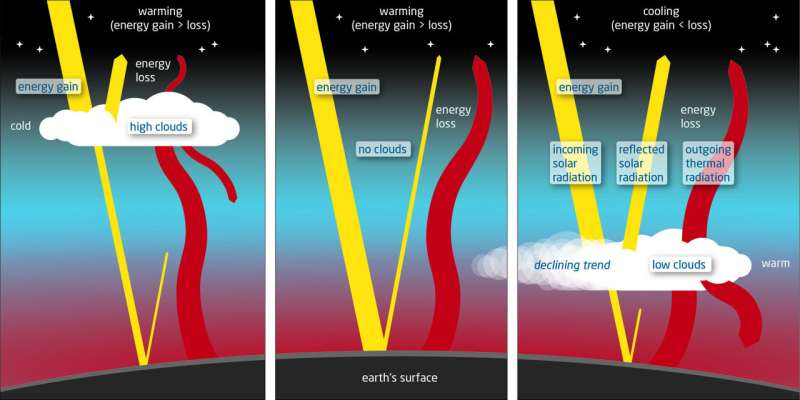Fewer low clouds means lower albedo: the Earth reflects less energy back into space and warms up faster. The disappearance of these "white sentinels" anticipates the worst climate scenarios. This is revealed by a new study coordinated by the Alfred Wegener Institute

@Canva
At most, it may have brought the world very close to exceeding the fateful threshold of +2.7°F relative to pre-industrial values during 2023-possibly even 2024-and outside the bounds identified for a tolerable Earth. Indeed, this is also often referred to as a ‘red line’ beyond which it has significant and devastating impacts on society and the ecology.
A new puzzle for climate science
With the enormous contribution factors of greenhouse gases build-up, El Niño, and glacial melting, for instance, these would still not fully explain the sudden and marked uprise in global temperatures.
According to a recent study by the Alfred Wegener Institute (AWI), there is suspicion of a previously overlooked culprit: the progressive decrease in certain types of clouds, especially low-altitude clouds. These clouds work like mirrors, reflecting solar radiation back into space. The Earth has apparently lost part of its natural “sunscreen,” causing it to absorb more and more solar energy and thus accelerate global warming.
Unexplained heat: a missing 0.36°F
The focus has traditionally been on increasing amounts of CO₂ and methane, fluctuations in El Niño, volcanic eruptions, and changes in solar output. While these account for a good deal of the warming, about 0.36°F (0.2°C) remains unaccounted for.
AWI researchers, working in cooperation with the European Centre for Medium-Range Weather Forecasts (ECMWF), compared satellite data and climate reanalyses going back to the mid-20th century. Their results indicate that 2023 will set a record low in the Earth’s albedo-the measure of how much sunlight the planet reflects. Though the steady drop in albedo has been attributed to the melting of Arctic and Antarctic ice, the accelerated decrease in the last few years is largely due to a decrease in low-altitude cloud cover-even at much lower latitudes.

@Alfred Wegener Institute
The earth as an imperfect mirror
Consider the Earth as a big, imperfect mirror. Bright surfaces and clouds reflect part of the incoming solar energy back into space. But with fewer bright surfaces and fewer low-level clouds, more energy is retained, and this further feeds warming.
The decline in low-level clouds has been most pronounced over critical areas of the North Atlantic, where marine heatwaves and extreme climate events were off the charts in 2023. Scientists say these phenomena are linked. The decline in low cloud cover and the associated drop in albedo explain a great deal about the mysterious 0.36°F warming gap.
Low clouds: the planet’s cooling shield
While high-altitude clouds can act as a heat trap, they also reflect a significant amount of sunlight back into space, which balances the effect to a large degree. Low-altitude clouds cool the planet mainly by serving as a solar umbrella. Losing them weakens one of our most important buffers against global warming. If this trend represents a feedback loop—where global warming itself reduces low cloud formation, creating a vicious cycle—it’s a big problem.
Why are we losing low clouds?
Several reasons might contribute to the above-mentioned phenomena:
- Fewer Aerosols: Stringent environmental controls on fuel for ships have resulted in fewer aerosol pollutants. Ironically, these particles facilitate cloud formation and reflect the sun.
- Natural Variability: Natural variations on short- to medium-term time scales could be contributing to cloud formation.
- Ocean Currents: Oceanic circulation patterns, which may be altered, are also a probable cause.
The most worrying explanation, however, is climate feedback: a warmer world can’t sustain its low cloud cover, and that accelerates the warming.
A new climate reality?
If these processes continue, the event of always staying above +2.7°F could happen decades earlier than expected, making it impossible to realize the goals of the Paris Agreement. Scientists emphasize the necessity of further research for separating temporary fluctuations from the new normal. Whatever the case, the message is clear: loss of low clouds badly cripples our ability to retard global warming.
Impacts on carbon budgets
The smaller albedo means that the “carbon budgets” of the world-representing the remaining amount of CO₂ we can emit without exceeding critical thresholds-must be recalculated. This dwindling budget shows the need to hasten the energy transition, forsake fossil fuels, and invest in sustainable technologies and practices.
A planet exposed
The Earth is ever more ‘naked’, without such reflecting clouds that block radiation from the Sun. Thus, this understated-yet-profound change tends to press heavy on planetary thermal balance. An atmosphere without these formations will leave its natural interplay of vapor and particles possibly being much more of a heat trap than it is presently.
But it does make a crucial point about one of the most under-discussed elements of climate science: low-altitude cloud cover plays a crucial cog in Earth’s climate system, and to see these clouds disappear is tantamount to removing a sponge that sops up excessive solar energy, accelerating an already dangerous trajectory.
The path forward
Faced with such evidence, the question is no longer whether to curb warming but how. If the skies become less reflective, humanity must compensate with greener solutions, acting swiftly and decisively.
